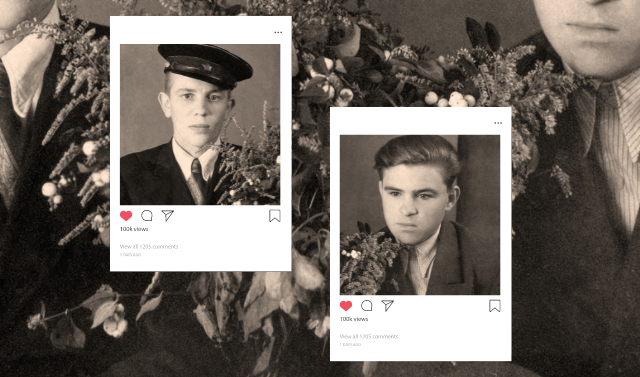Sign up for the Family Tree Newsletter Plus, you’ll receive our 10 Essential Genealogy Research Forms PDF as a special thank you!
Get Your Free Genealogy Forms
"*" indicates required fields

Fred Astaire and Ginger Rogers. The Three Stooges. The A-Team. The New England Patriots. Cinema, comedy, television crime-fighting and sports all have successful teams. And so does genealogy. That’s right—family historydom is populated with plenty of dynamic duos, talented trios and effective families that work together to conquer tough brick walls.
Take the winners of our 2008 Terrific Family Tree Teamwork contest: Bev Ophoven Ewing and Kathleen Lenerz told us how their 10-year research partnership began back in 1998, when Kathy (in Connecticut) emailed Bev (in Minnesota) with a question—had her Meyer relatives lived next to the Lenerz family in Dane County, Wis., from 1855 to 1860? Turns out both women’s third-great-grandmothers had the maiden name Schneider. Bev researched on-site in Wisconsin; Kathy studied newspaper microfilm and posted on mailing lists. Once the relationship was confirmed through an obituary and German Familienbücher, Kathy went on to research naturalization papers while Bev pored over microfilmed German church records. As they continue to tackle mysteries, they bounce ideas around, build off each other’s thinking, and divide up tasks according to their interests, knowledge and skills.
Contest runners-up—mentioned throughout this article—told even more tales of effective genealogy collaborations. Their stories show the advantages of a group approach to research: You’ll generate more potential solutions, accomplish more tasks and have more fun. You, too, can join the ranks of successful genealogical teams with our eight-point playbook.
1. Recruit your research team.
To build a research team, of course, you’ll need to do some recruiting. Genealogy-minded relatives are a natural starting point. Reader Valerie Craft’s mom encouraged her to try a family history college project and made phone calls to put her in touch with distant relatives. You can look for unknown-to-you relatives who are researching your lines using message boards (try the ones at Ancestry.com) or one of the many genealogy-related Facebook pages.
Your local genealogical society or the one where your ancestors lived is a great source of research collaborators. In 2006, reader Melissa Hogan found a team in the Chilton County (Ala.) Yahoo! genealogy group (no longer active). They turned out to be relatives, but your team members don’t have to be in your family. Try an “ancestor exchange” by helping out someone who lives in your ancestral hometown and has forebears near you. She can do research favors for you in return.
Once you’ve found someone, test your compatibility quotient and propose a partnership by asking how long the person has been researching the family, and if he or she ever has thought about collaborating with someone on research.
2. Set ground rules.
Just because you share an interest doesn’t mean you think the same way. Having a set of ground rules helps establish how decisions are made and information is shared, says Marlene K. Rebori, a specialist in community development with the University of Nevada, Reno Cooperative Extension. Talk about how you’ll keep in touch (phone or email) and how often (weekly, monthly or when new information appears). Who’ll keep notes on all your joint discoveries? All group members should receive copies of relevant records, but one person should be your official “archivist.” Outline how data will be shared, too: For example, you might not want a well-meaning team member to post living relatives’ names on the internet.
Don’t forget about money—copy fees and record request charges can quickly add up. You may want to discuss a budget and let everyone contribute what they’re able, so no one person gets stuck footing the whole bill. Decide which expenses are shared (vital records fees, maybe) and which ones individuals will shoulder (such as a research trip to the Family History Library in Salt Lake City).
Your arrangement may not be this formal. If your team naturally falls together, as Ewing and Lenerz did, and you all have similar research methods and dedication to the project, you may not need quite as many set guidelines.
3. Define the project.
Whether you want to tackle a specific brick wall ancestor or just learn more about your family in general, a common purpose draws your team together. Ewing and Lenerz needed to solve the mystery of their disappearing Dietrich family. For reader Gwendolyn Cameron and her cousins, the goal was to reveal the troubled life of their great-grandfather William Baughman, a Civil War veteran. The Chilton County group wanted to find the fate of their ancestor Martin Monroe Robinson, who family legend said had served prison time. Your team’s goal may be clear-cut from the outset—if not, look at your family tree, brainstorm possibilities and agree on what to research first.
4. Make a plan.
Before you get carried away with genealogical fervor, review together each team member’s research. Then plan steps to accomplish each goal — reference books to peruse, microfilm to rent, databases to check. Hogan’s team sent one person to the Alabama state archives and the National Archives‘ regional facility in Atlanta. Others searched newspapers and checked county courthouses.
When divvying up who’ll do what, keep in mind the complexity of the tasks and the time each may take. Manually reviewing records in the courthouse basement is probably more involved than sending for copies of vital records. Also take into account the expertise and interests of each person, and where he or she lives. If cousin Jean calls Washington, DC, home, she’s a natural for going after Civil War pension records at the National Archives. You, the census genius, can set about documenting your Howard family in 19th-century census schedules.
5. Stay organized.
Especially if you’re coordinating a large project with a big team, you’ll need to stay focused. Designate someone to keep track of research tasks, who’s doing them and how they’ve progressed, as well as any expenses. You might consider using an organizing app such as Evernote or a shared Google Doc to keep track. Family Tree Magazine has several research forms, including a Genealogy Project Management Worksheet, you can download for free.
6. Communicate early and often.
The beauty of teamwork is that you can offer guidance, share the disappointments of brick walls and celebrate the glory of extending the family tree. You won’t get these benefits going solo, so capitalize on them with a communications strategy. Meet regularly (if everyone’s local) or check in by phone or email (as Ewing and Lenerz did for their long-distance partnership). Assign a team member to periodically email progress reports, or join a site such as Geni to relay your findings.
On any team, some folks will speak up while others will hold back. If you disagree about where ancestors settled or which birth date is really Great-grandpa Jeb’s, it may help to focus on ideas, Rebori suggests, not necessarily solutions. When you start by discussing theories about who, what, when and why your ancestors did or didn’t do something, you won’t get bogged down in which research strategy is right. Conflicts often pave the way to new discoveries if teammates respect and listen to each other’s ideas and theories.
7. Spread the word.
Sharing your findings will draw your family closer and maybe even get others interested in your quest. You could create a book of stories as reader Susie Bullion did, give relatives decorative family trees or create a family history website with photos and documents or do something even more creative.
Cameron and her cousins invited relatives (including some they’d never met) to a funeral service at which William Baughman, who survived severe war injuries only to die at the State Hospital for the Insane in North Warren, Pa., received a headstone after more than a century in an unmarked grave. “On Sept. 23, 2006, the five of us and our families met at Warren State Hospital to honor William with a military funeral, 118 years belated,” says Cameron. Civil War re-enactors, a state representative and reporters also attended. The hospital even launched a project to identify and mark the 953 other graves.
Try to introduce team members who are distant relatives to your part of the family tree, too. This could inspire a great-aunt who might remember hearing about the branches’ ancestral connections. If your genealogical research brings cascades of kudos, remember to share the wealth for your group effort.
8. Keep it going.
You and your genealogy compadre worked together on a long-term project and talked weekly about your common interest. At some point, you became friends. When you’ve reached your genealogy goal, chat about how the search evolved into a friendship. Then keep the collaboration going. Take a second look at your family tree and find another problem to explore. Ewing and Lenerz are still collaborating, though they’ve never met. “Despite time gaps in our contacts, we easily pick up where we left off,” says the duo. “But most importantly, we’ve developed a strong friendship and an abiding respect for each other.”
No matter how finished you think your project is, there’s always a new problem to solve and a reason to keep the spirit of collaboration alive. Inevitably, your team will revisit the tips here. At every fork in the research road, you’ll have to reassess your strategy. Keep communicating regularly with your genealogical partner and sharing every big find with the rest of the clan. Maybe you’ll never waltz with the grace of Fred and Ginger or Nyuk! Nyuk! quite the way Curly and company did, but as readers show, you can be part of a successful genealogy team.
A version of this article appeared in the November 2008 issue of Family Tree Magazine.
Updated: August 2021
ADVERTISEMENT




